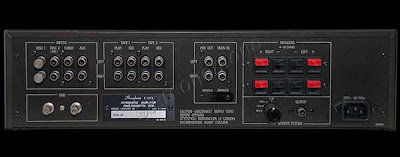
Kensonic Laboratory has called upon the highest grade separate amplifier design technology to create Accuphase E-203 Integrated Stereo Amplifier. Its power output stages empliy MOS FETs which are considered the most advanced ideal devices for such applications. They are used in complementary-symmetry push-pull output stages that give full play to their superior characteristics to produce a far superior outstanding sound quality.
The E-203 has a power output of 70 watts per channel (8 ohm load, 20 -20,000 Hz, less than 0,01% distortion) which is ample for even the most spacious hi -fi home listening rooms. It is a pure DC amplifier which produces practically no sound coloration because of its special DC Servo Control system for its tone control sections and power output stages.
One of the main features of the E-203 is the extra rich bass reproduction that becomes a possibility because of its built-in , low-pass filter network whose output can be fed to separate sub-woofer system. A richer bass emphasis can be obtained by connecting monophonic power amplifier and sub-woofer to this filter output.

All unit amps are DC types, with pure DC amplifier design adopted throughout. large capacity, direct current blocking capacitors in the NF loops have been completely eliminated so there is no sound coloration.
The E-203 employs these powerful MOS FETs. Two of them are used in a push-pull output stage, and account for the high output power of 70 watts per channel. The MOS FET has a very high gain equivalent to two or three stages of directly coupled Darlington Pair amplifier circuits using bipolar transistors. The number of stages can therefore be reduced, and superior performance achieved. The bipolar transistor may seem to have many shortcomings from the above explanation. It was presented only as a matter of comparsion, however it is tru that a high perfection amplifier can be made even with bipolar transistors if it is well-disigned.
The E-203 is provided with a built-in, low-pass filter network to which can be connected to a sub woofer system to obtain a very rich luxuriant bass response. The low-pass filter network has three, high-side cutoff frequencies of 50 Hz, 70 Hz and 100 Hz, from which the most siutable can be selected, depending on the left and right channel bas response of your speaker systems.
In order to reduce further the tonal coloration effects of capacitors, the input capacitors of unit amplifiers were also eliminated. As a result, there is only one capacitor used in the signal path circuit all the way from AUX and Tuner inputs to the final output.
Low noise active devices must be used in the equalizer input circuit to achieve high S/N ratio, but this alone is insufficient. Low noise parts and elements must be used as well. Low impedance of the feedback loop is also most important to obtain low current-noise and thermal-noise.
Class-A operation with large current flow in the final equalizer transistors has lowered the impedance of the NF loop, and greatly reduced the noise generated at the differential input circuit.

Specifications
Power output (both channels driven, 20 - 20,000 Hz, no more than 0,02% THD):
90 watts at 4 ohms;
70 watts at 8 ohms;
35 watts at 16 ohms
Total Harmonic Distortion (both channels driven, 20 - 20,000 Hz, at any power output from 1/4 watt to rated power):
0,02% max. at 4 ohms;
0,01% max. at 8 ohms;
0,01% max. at 16 ohms
Frequency Response (Main Amp Input):
20 - 20,000 Hz; +0, -0,2 dB at rated power output,
2 - 200,000 Hz; +0, -3,0 dB at 1 watt power output
High Level input Frequency response: 20 -20,000 Hz; +0, -0,2 dB at rated power output
Low level input Frequency response: 20 - 20,000 Hz; +0,2, -0,5 dB at rated power output
Dampingg Factor: 50 at 50 Hz
Intermodulation Distortion: will not exceed 0,005% at rated power output
Input Sensitivity and Impedance (IHF standard):
Disc 2/MC: 0,011 mV at 100 ohms;
Disc 1/MM: 0,22 mV at 100 ohms, 47 kohms, 100 kohms;
Aux, Tape, Tuner: 14,3 mV at 47 kohms;
Main Amp : 0,11 mV at 47 kohms
Maximum Input for Disc Input (0,01% THD):
Disc 2/MC: 10 mV RMS at 1 kHz;
Disc 1/MM: 200 mV RMS at 1 kHz
Output Level and Impedance:
Preamp. Output: 0,95 V rated input level, 200 ohms;
Tape Rec 1, 2: 120 mV at rated input level, 200 ohms
Voltage Amplification in Decibels
Main Amp Input to Output: 27,8 dB;
High-level Input to Preamp Output: 18,4 dB;
Disc 1 Input to Tape Rec: 36 dB;
Disc 2 Input to Tape Rec: 62 dB
A-weighted Signal-To-Noise Ratio (IHF standard):
Main Amp Input: 95 dB;
High Level Input: 82 dB;
Disc 1/MM: 80 dB;
Disc2/MC: 75 dB
Tone Controls:
Bass: 200 Hz; ±10 dB at 50 Hz; 500 Hz; ±10 dB at 100 Hz
Treble: 2 kHz: ±10 dB at 10 kHz; 7 kHz: ±10 dB at 50 kHz
Loudness Compensator (volume attenuation at -30 dB):
Comp 1: +9 dB at 50 Hz;
Comp 2: +10 dB at 50 Hz, +6 dB at 20 kHz
Subsonic Filter: 17 Hz cutoff 12 dB/oct.
Attenuator: -20 dB
Output for Sub-woofer System (monophonic):
Output Level: +6 dB
Cutoff Frequency: 50 Hz, 70 Hz, 100 Hz and flat position
Cutoff Slope: -12 dB/oct.
Output impedance: 200 kohms
Output load Impedance: 4 to 16 ohms
Semiconductors: 52 transistors, 14 ICs, 10 FETs, 23 diodes
Power Requirement: 100, 117, 220 and 240 V, 50/60 Hz
Power Consumption:
55 watts at 0 Signal output;
300 watts at rated power output into 8 ohms load
Dimensions (W x H x D): 445 x 128 x 370 mm ( 17-1/2" x 5-1/16" x 14-9/16")
Weight net: 14,7 kg (32,3 lbs)

Hello,¡!
RispondiEliminaI have this amp,wich cartridges
works fine with the phono section.
My turntable is a rega p25
Thank you.